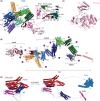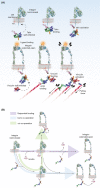Bottom-up reconstitution of focal adhesion complexes
- PMID: 33999507
- PMCID: PMC9290908
- DOI: 10.1111/febs.16023
Bottom-up reconstitution of focal adhesion complexes
Abstract
Focal adhesions (FA) are large macromolecular assemblies relevant for various cellular and pathological events such as migration, polarization, and metastatic cancer formation. At FA sites at the migrating periphery of a cell, hundreds of players gather and form a network to respond to extra cellular stimuli transmitted by the integrin receptor, the most upstream component within a cell, initiating the FA signaling pathway. Numerous cellular experiments have been performed to understand the FA architecture and functions; however, their intricate network formation hampers unraveling the precise molecular actions of individual players. Here, in vitro bottom-up reconstitution presents an advantageous approach for elucidating the FA machinery and the hierarchical crosstalk of involved cellular players.
Keywords: PIP2; actin; integrin; talin; vinculin.
© 2021 The Authors. The FEBS Journal published by John Wiley & Sons Ltd on behalf of Federation of European Biochemical Societies. This article has been contributed to by US Government employees and their work is in the public domain in the USA.
Conflict of interest statement
The authors declare no conflicts of interest.
Figures




References
-
- Geiger B, Bershadsky A, Pankov R & Yamada KM (2001) Transmembrane crosstalk between the extracellular matrix–cytoskeleton crosstalk. Nat Rev Mol Cell Biol 2, 793–805. - PubMed
-
- Winograd‐Katz SE, Fassler R, Geiger B & Legate KR (2014) The integrin adhesome: from genes and proteins to human disease. Nat Rev Mol Cell Biol 15, 273–288. - PubMed
-
- Wozniak MA, Modzelewska K, Kwong L & Keely PJ (2004) Focal adhesion regulation of cell behavior. Biochim Biophys Acta 1692, 103–119. - PubMed
-
- Legate KR, Wickstrom SA & Fassler R (2009) Genetic and cell biological analysis of integrin outside‐in signaling. Genes Dev 23, 397–418. - PubMed
-
- Hynes RO (2002) Integrins: bidirectional, allosteric signaling machines. Cell 110, 673–687. - PubMed
Publication types
MeSH terms
Substances
LinkOut - more resources
Full Text Sources
Other Literature Sources

